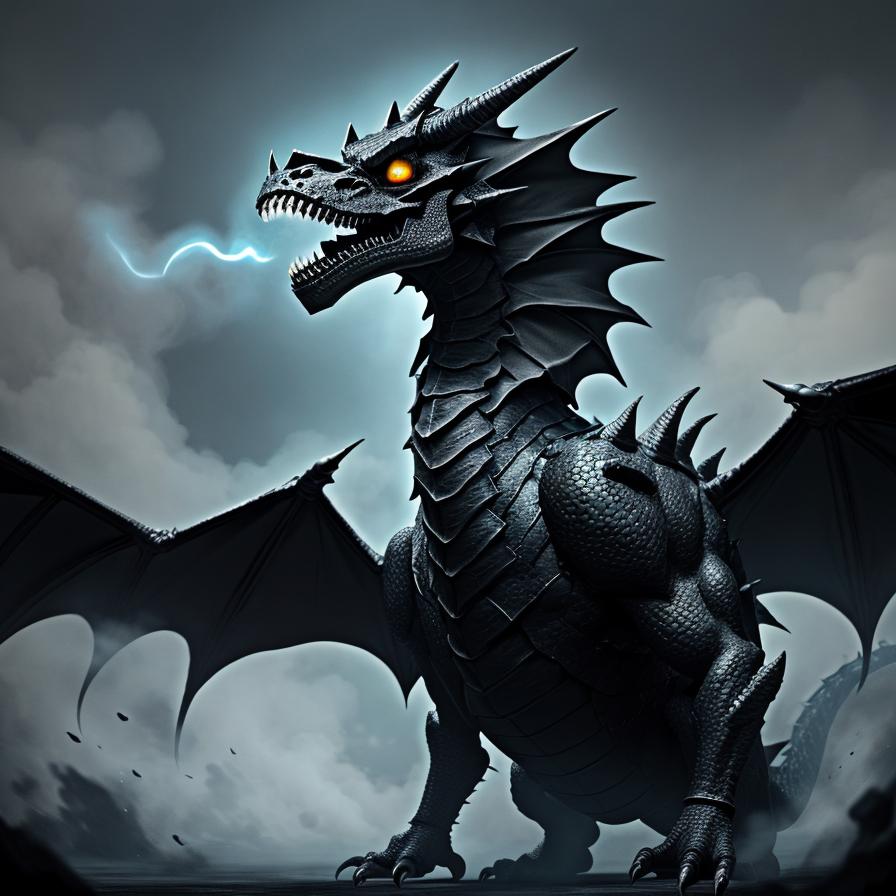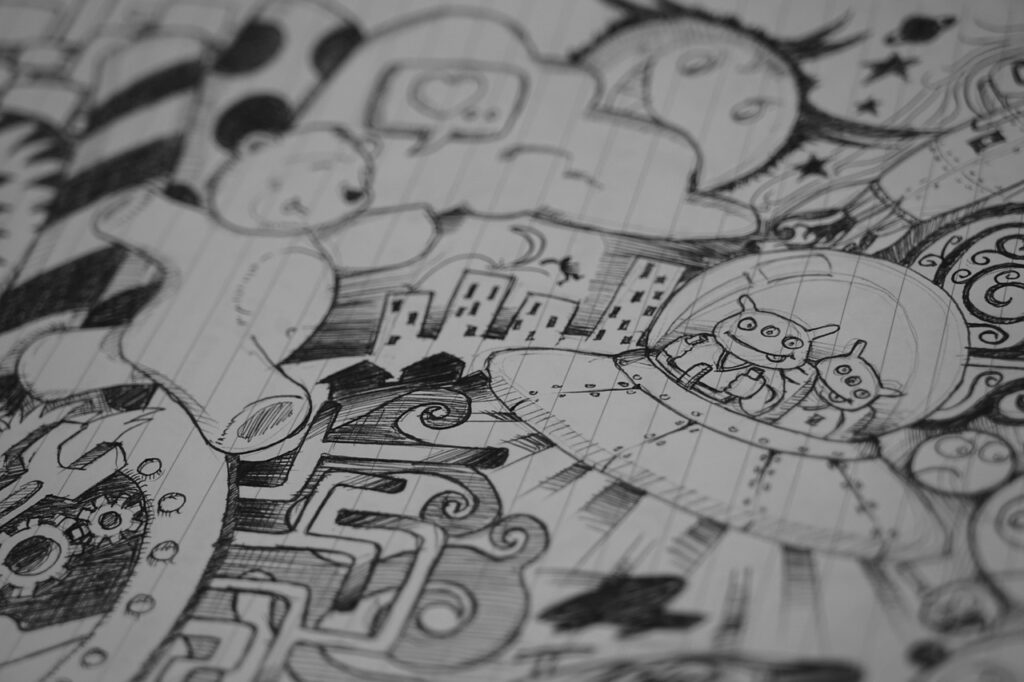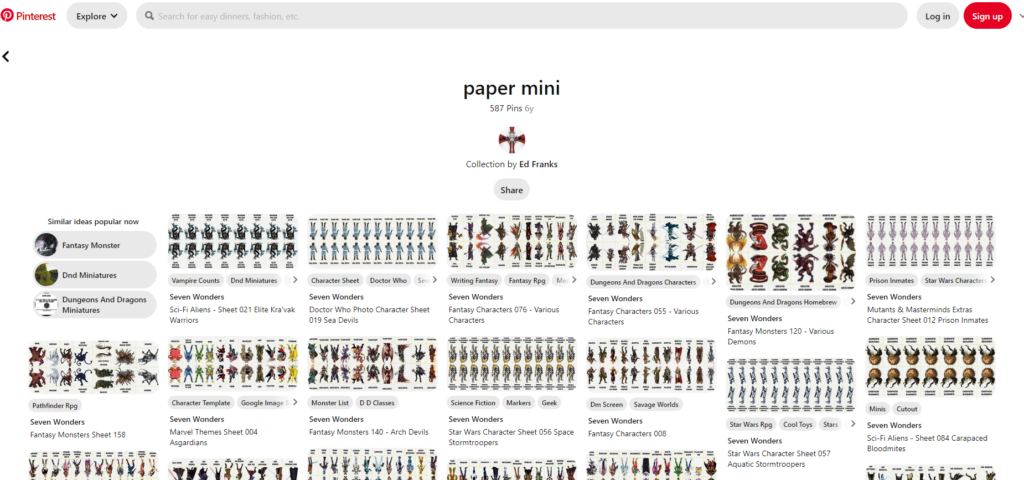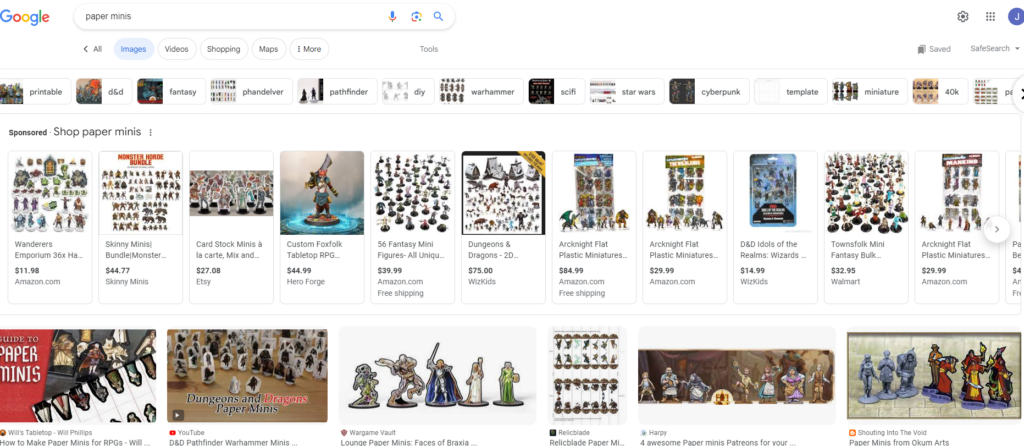This post contains some affiliate links. Any purchase using those links results in a direct benefit to Session 0 Studios.
Depending on your playstyle, playing D&D with minis can be one of the most fun ways to make combat encounters more immersive and more tactically challenging. The problem that arises then is how to have minis for every monster in every situation. Naturally, you can’t have every mini of every monster just because with storage alone that would be a nightmare. But you might be able to still have every monster, with paper minis for D&D.
But first…
Honestly, paper minis are exactly what they sound like. Instead of a miniature representation of a galeb duh or a tarrasque made out of plastic, metal, plaster, or wood, you have your mini made out of paper. Pretty simple and self-explanatory.
There are also lots of reasons why someone would use paper minis over plastic minis as is traditional.
The first is the obvious ease of creation. You can simply print minis on paper, hopefully a thicker cardstock, and you are good to go. As long as you have a printer or a printshop nearby you are ok.
The second, major benefit of using paper minis, is the ease of storage. Because paper minis are, well, paper thin, you can store them in a much small space than 3D minis. It’s amazing what an extra dimension will do for you.
The third major benefit is the simplicity of finding the models. For the most part, barring any commercial campaign you run, you can just find images online and print them off. They can be SVGs, JPEGs or whatever. Just as long as you can print them it doesn’t matter.
Overall, paper minis seem like a great gig.
Naturally, everything has its pros and cons, and paper D&D minis are no different.
The first disadvantage that they have is that they are not 3D. This is really only a disadvantage if you care heavily about that sort of thing. Having 3D minis is cool, but if you don’t have them, it’s not the end of the world.
The second disadvantage is that it might be easier for the paper minis to get ruined. Paper can get folded, crinkled, or torn much easier than a 3D mini… sometimes. Some 3D minis are fragile, and some paper minis are laminated. Obviously that brings up the cost of the paper minis so there is a trade off.
The last disadvantage is related to the first disadvantage. Because the minis are 2D it might be hard for everyone at your table to see the minis and get a read on everything that is happening. Depending on your table, you might be fine.
So with the disadvantage and advantages covered, let’s talk about…
There are really 4 types of minis, you can have a top-down-side-profile mini, a top-down-top-profile mini, a completely side profile mini, or a token mini. Since the top-down-side-profile mini will likely be much less common, we won’t talk about that one. The difference between these minis is their display, and the view that the user has of the depicted creature.
With a top-down-top-profile mini, the artistic depiction of the mini views the creature in question as if from above with only a top down view. This means that you don’t get may features that would help identify creature. Since most battlemaps where a mini would be used are technically using a top-down view, this isn’t so much of a problem as long as all of the players know what the creature is. The benefit with this mini is that once you have it created, you don’t need a stand or anything.
With a completely side profile view, you can get much more detail, because the graphic of the creature depicts it as seen from one complete plane, such as the front back, or sides. With this type of mini, you’ll likely want to buy some paper stands, like these on Amazon. That does make this option a little pricier, but not much. The nice benefit of this type of minis is that you can print a front and back (if you are a wiz with printing or if you want to glue two pieces of paper together). It can let your players have a more 3D view of the minis, without needing 3d minis.

Lastly, with token D&D minis, you’ll simply have a geometric shape, usually a circle, within which is a graphic depicting the creature, usually focusing on its head features to best give the players an understanding of what the creature is. For example, if you had a Red Dragon that the party were fighting, then the token would have just the head of the red dragon. Obviously you can see some drawbacks of this method, for example, if you had an adult red dragon and a young red dragon it might be hard to see the difference. Still this is a good method.
One thing you might have noticed by now is that when you play D&D online, it’s very possible that these same mini methods are used in your online game. You might use a toke D&D mini or a top down view. So some of you might be already familiar with playing in this playstyle.
So the materials you need to make the minis will depend on the type of minis. Basically you’ll need something to put the design on. Since we are talking about making paper minis, you’ll need paper. If you want to add something to that paper, then you’ll need that as well. For example, you could laminate the paper minis or glue two inverse versions of a paper mini to a cardboard cutout to make the mini a little more sturdy. There are a lot of options.
You may also need some sort of stand if you want upright minis. As I mentioned before these stands from Amazon are a great choice.
Lastly, you’ll need something to actually make the minis, like a printer or pens and pencils if you are artsy. That’s really all you need to make paper minis. It’s a very simple and cost efficient process which is one of the advantages of using these types of minis.

Since the process is simple, I won’t take too long going over the steps, but they are here if you want them.
The first thing you need to do is pick the actual minis you want. As we’ve talked about before you’ll want to decide what type of mini you prefer (the token, the side-profile-standing, or the top down mini, or an abstract 4th option that I haven’t mentioned here).
Once you’ve chosen your type, you also need to think about Copyright rules and if they apply to your game. Chances are you aren’t going to be reselling your minis or using them in a liveplay game that is monetized, so the vast majority of people won’t even need to worry about copyright. You can just use whatever. If, on the off-chance, you have monetized your game somehow, make sure whatever images you use are correctly attributed and also that you are using them correctly.
If you are looking for great images to use, a great place to look is Pinterest. There are hundreds of thousands of great options there and the best part is that they are all free. Another great place is Google Images. Whether you want to draw your own or just take a digital image, these are great tools.

Now, perhaps a controversial topic, but theoretically, you could use an AI image generator to help you create some of your minis. I will say that AI image generators can do a lot of amazing things. You also need to be really good at crafting prompts. Even with a great prompt, you’ll likely need to have some skill with photoshop or illustrator to get rid of 7-fingered hands and so forth. Also, it’s generally a good practice to disclaim that you used an AI image generator, especially with monetized projects. That said, they are fun to use and experiment with, so go crazy.
Now, you can obviously pay someone to do an image for you. There are sites like Fiverr and Upwork where you can happily pay someone a fee to create you some nice images. I’m pretty cheap so I wouldn’t resort to that off the bat.
This step is pretty simple to understand, but probably the hardest step. If you are printing things out, then you might consider using tools like Canva to size the image how you want to. If you need to send your image to a print shop, then work with them to get it how you want it.
If you are drawing or doodling your image, the best I can say is good luck. I was not born with the artistic gene. In fact, you might even say I am the oppositive of aesthetically astute. There are thousands of places that you can go though to get some advice or even honest feedback on your work. One place is the Guild. You can sign up for free and then meet other dungeon masters and creators to see what they think about your creation.

Now is the fun part where you get to see it all come together. Take your printed minis or your drawn minis and assemble first the materials you need to make them. So if you are laminating them or putting them on cardboard, get all that material.
Now, this is very important. Do not get to gluing right away. Instead, line everything up. Make sure you know how it will all fit together before you adhere anything to anything else. This will save you some headache when you inevitably accidentally glue the wrong thing to the wrong thing. Remember, as they used to say in wood shop: measure twice and cut once.
Once you have your fantastic paper D&D minis, you need to use them. You’ll probably end up creating minis for each session you do, so you’ll likely end up using them.
The real trick will be to store them in correct and useful ways. You want to store them so that you can find ones you’ve already made and save yourself some time and money later.
For storage, you might consider a nice fishing tackle box like this one. It doesn’t matter what you use, just as long as it keeps the minis in tip top shape, and it’s easy to access and rifle through.
Now you have a general idea of how to make paper minis for your D&D games, but let’s dig in a little deeper and talk about some extra tips that may come in handy.
If your players are inclined or if they have the special wherewithal, let them help make the minis. Obviously this takes away some of the surprise, but if you are smart, you can have them work on a large batch, and then only use a small amount of that batch immediately. The more minis they work on, the more likely it will be that they will forget any single mini they put their hands on.
Don’t hold back. If you have a cool idea that goes against something I’ve mentioned in this post, do it! You could help us come up with a fourth model of paper minis that revolutionizes the game! Or you can just have a really cool gaming experience with your friends because of an image that you came up with.
Also, in this post, we’ve only talked about making paper minis. That doesn’t touch making paper terrain at all. If you have a cool idea, then roll with it, especially if it ends up with you having an awesome cardboard castle!

D&D is a long term game and you and I are in it for the long-haul. If your players balk at the use of paper minis, don’t listen to them. You are the DM and frankly, you are the one spending countless hours and effort and possibly money to help them have a fun gaming experience. If they don’t like it, they can shove it. Besides, as I’ve said many times before, the only things you really need to play D&D are friends, a story, and a shared set of rules. Everything else is just extra.
If you feel like your minis suck or that it’s weird or that you aren’t that good, don’t worry. Stick with it and you will get better. Everyone has to put out some stuff that they aren’t proud of. The first podcast I ever did was called Streams of Consciousness. The idea was that me and a couple friends would basically play that game where you tell a story but you only get to say a sentence at a time. It was fun but thinking back to it, no wonder we had absolutely no listeners. But it’s ok. It was fun like I said, and I got started and improved what I was doing. So just do it, have fun and know you’ll get better.
Now, if you are looking for digital images of minis there are a few places to look as well as a few tools to use.
Pinterest is amazing for looking for minis. It has so many options that it is almost daunting looking for something. You can find realistic looking images all the way to cute anime styled images. It really just depends on what you want. Sometimes you might have trouble copying and pasting the images, but for most people that shouldn’t be an issue.

Next place you can look is Google Images. The downside with this tool is that the images aren’t always as high quality as you will likely find on Pinterest. That said, Google is the largest search engine for scouring the web so you should be able to find something. Just search what you want in the search bar and make sure the “Images” option is clicked so that it only gives you image results.

If you are willing to spend a little more time working on prompts you can use tools like Midjourney or Nightcafe. You can create some really interesting images, and Nightcafe is partly free. That said, you will have to finesse the prompts you give to these generators and also sometimes the images are just weird and unnatural.
Another tool that you might not have considered is called Lightshot. It’s a screenshot tool that I absolutely love. The reason you might use something like this is that you can use it in conjunction with some other tools or you can pull images straight off the web. (Both of the above Screenshots were pulled using Lightshot).
While paper minis are the less expensive version of minis, they are by no means the less fun. You can have just as fun of combat sessions as you would with plastic minis. So find your minis, print them out, stand them up and get playing.
With all of this knowledge that I have bestowed on you, go forth and conquer the world of D&D! But seriously, I hope that I’ve been able to help you improve your gameplay for not that much extra time or money. D&D is awesome and there is nothing in the rules that says you have to spend every nickel and dime you have (also, bonus points if you still use real money rather than digital money).
As you go and fill your time with Adventure, remember that you aren’t alone. You can always reach out to other Dungeon Masters who are just like you, and have so much knowledge and wisdom, it’s crazy. I’m talking about our Free Community of Dungeon Masters, The Guild. All you need to do is sign up, and then go be active on our Discord and you’ll have all the resources you’ll ever need. At the end of the day, D&D is a game of friends, whether you play with plastic or paper minis, it’s all about friends. Make sure that however you play, you are always making more and more friends. Let us know how your paper minis turned out too. We’d love to see your progress.
Copyright Monsters.Rent 2023